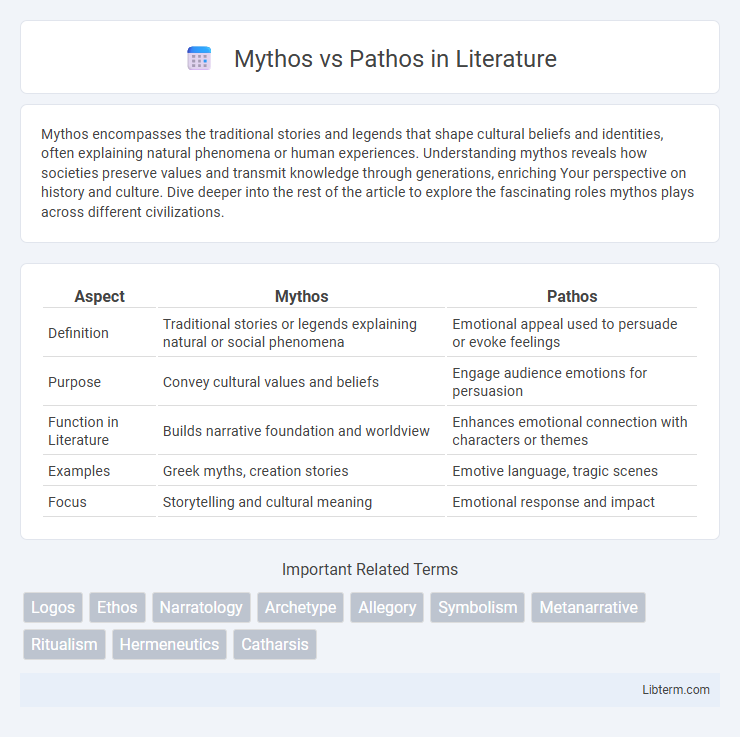Mythos encompasses the traditional stories and legends that shape cultural beliefs and identities, often explaining natural phenomena or human experiences. Understanding mythos reveals how societies preserve values and transmit knowledge through generations, enriching Your perspective on history and culture. Dive deeper into the rest of the article to explore the fascinating roles mythos plays across different civilizations.
Table of Comparison
| Aspect | Mythos | Pathos |
|---|---|---|
| Definition | Traditional stories or legends explaining natural or social phenomena | Emotional appeal used to persuade or evoke feelings |
| Purpose | Convey cultural values and beliefs | Engage audience emotions for persuasion |
| Function in Literature | Builds narrative foundation and worldview | Enhances emotional connection with characters or themes |
| Examples | Greek myths, creation stories | Emotive language, tragic scenes |
| Focus | Storytelling and cultural meaning | Emotional response and impact |
Introduction to Mythos and Pathos
Mythos and Pathos represent distinct modes of persuasion and storytelling rooted in ancient rhetoric and literature. Mythos refers to the use of traditional stories, cultural myths, and collective narratives to convey values and beliefs, often appealing to a sense of shared identity and heritage. Pathos, on the other hand, targets the audience's emotions, aiming to evoke feelings such as sympathy, anger, or passion to influence opinions and motivate action.
Defining Mythos: The Power of Narrative
Mythos refers to the compelling power of narrative that shapes cultural values and collective identity through stories and myths. It operates by embedding meaning within symbolic frameworks, influencing beliefs and guiding social behaviors beyond mere factual evidence. Understanding Mythos is crucial for harnessing storytelling in persuasion, as it taps into emotional resonance and shared heritage.
Understanding Pathos: The Influence of Emotion
Pathos represents the emotional appeal that persuades audiences by evoking feelings such as empathy, anger, or passion. This rhetorical technique leverages emotional responses to create strong connections between the speaker and the audience, enhancing message retention and persuasion. In contrast to Mythos, which relies on cultural stories and values, Pathos directly targets individual emotions to influence decision-making and attitude change.
Mythos vs Pathos: Core Differences
Mythos and Pathos represent distinct modes of persuasion rooted in ancient rhetoric, with Mythos appealing to shared cultural narratives and collective identity, while Pathos targets individual emotions and personal feelings. Mythos leverages storytelling traditions and communal beliefs to create resonance among audiences, whereas Pathos uses emotional triggers such as sympathy, anger, or joy to influence decision-making. Understanding the core difference lies in Mythos framing arguments through societal myths and values, contrasting with Pathos's direct engagement with the audience's emotional state.
Historical Perspectives on Mythos and Pathos
Ancient Greek philosophers differentiated Mythos as narrative storytelling embedding cultural values, while Pathos referred to emotional appeal influencing human behavior and decision-making. Aristotle's rhetoric classified Pathos as a critical mode of persuasion by evoking audience emotions, contrasting with Mythos, which conveyed traditional myths and collective identity. Over time, these concepts evolved, with Mythos shaping societal mythologies and Pathos underpinning techniques in literature, drama, and rhetoric across historical epochs.
The Role of Mythos in Cultural Storytelling
Mythos serves as the foundational framework in cultural storytelling, shaping collective identity through shared myths, legends, and traditional narratives that encapsulate societal values and beliefs. It conveys universal truths and historical continuity, binding communities by providing a sense of belonging and purpose across generations. Unlike pathos, which appeals to individual emotions, mythos cultivates a collective emotional resonance rooted in cultural heritage and collective memory.
How Pathos Drives Human Connection
Pathos drives human connection by evoking deep emotions such as empathy, compassion, and passion, which create a shared understanding between individuals. Emotional appeal triggers neurological responses that strengthen bonds and encourage trust, making communication more persuasive and memorable. Unlike Mythos, which relies on cultural narratives, Pathos leverages universal feelings to foster immediate and profound relational engagement.
Mythos and Pathos in Literature and Art
Mythos in literature and art refers to the use of traditional stories, legends, and cultural narratives that convey collective beliefs and values, shaping the audience's understanding through symbolic meaning. Pathos evokes emotional responses by appealing directly to the audience's feelings, often through vivid imagery, dramatic scenes, or relatable characters that foster empathy and connection. Together, Mythos grounds a work in shared cultural significance while Pathos drives personal engagement, creating a powerful dynamic that enriches storytelling and artistic expression.
Modern Applications: Mythos vs Pathos in Media
Mythos and pathos play crucial roles in shaping narratives across modern media platforms, with mythos providing cultural and historical frameworks that resonate deeply in storytelling. Pathos targets emotional engagement, often driving audience connection through evocative imagery and relatable character experiences. Together, these elements enhance persuasive communication and strengthen viewer loyalty in advertising, film, and social media campaigns.
Conclusion: Balancing Mythos and Pathos
Balancing mythos and pathos enhances persuasive communication by integrating cultural narratives with emotional appeal, creating deeper audience resonance. Effective messaging blends mythos's appeal to shared values and identity with pathos's ability to evoke empathy and emotional connection, fostering trust and motivation. This synergy elevates rhetoric, ensuring messages are both meaningful and memorable.
Mythos Infographic

 libterm.com
libterm.com